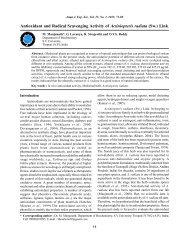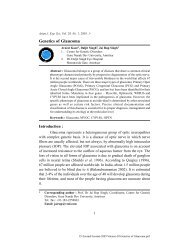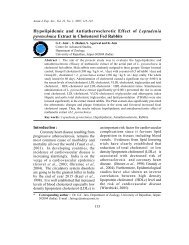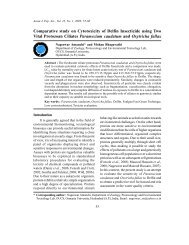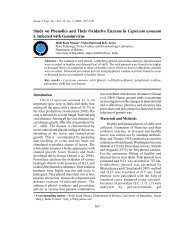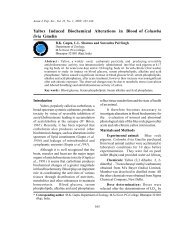Control of Aspergillus parasiticum NCIM 898 infection in ... - Ajes.in
Control of Aspergillus parasiticum NCIM 898 infection in ... - Ajes.in
Control of Aspergillus parasiticum NCIM 898 infection in ... - Ajes.in
You also want an ePaper? Increase the reach of your titles
YUMPU automatically turns print PDFs into web optimized ePapers that Google loves.
ecosystem. A bacterial community <strong>in</strong> contam<strong>in</strong>ated site<br />
tends to be dom<strong>in</strong>ated by the stra<strong>in</strong>s that survive the<br />
zenobiotic entity or is able to utilize it for its growth. In<br />
response to paraff<strong>in</strong> oil <strong>in</strong> the Christova's medium the<br />
organisms which are already acclimatized to the<br />
hydrocarbons <strong>in</strong> spilled eng<strong>in</strong>e oil, grease, petrol, and<br />
diesel could utilize paraff<strong>in</strong> as a sole source <strong>of</strong> carbon<br />
and hence could be obta<strong>in</strong>ed <strong>in</strong> higher numbers as<br />
compared to those obta<strong>in</strong>ed from other sampl<strong>in</strong>g sites.<br />
Bernheimer and Avigad (1970) reported that the<br />
biosurfactant produced by Bacillus could lyse blood and<br />
s<strong>in</strong>ce then has been used to quantify surfact<strong>in</strong>s (Moran et<br />
al., 2002) and rhamnolipids . Johnson and Boese-<br />
Marrazzo, 1980 and Carrillo et al. (1996) found an<br />
association between haemolytic activity and surfactant<br />
production, and recommended the use <strong>of</strong> blood agar for<br />
observ<strong>in</strong>g lysis as a primary method to screen for<br />
biosurfactant activity. Aga<strong>in</strong>st the Cx ratio <strong>of</strong> 1.6 and<br />
1.55 and % heamolysis <strong>of</strong> 22% and 24% obta<strong>in</strong>ed with<br />
standard stra<strong>in</strong>s Bacillus subtilis MTCC 2423,<br />
Pseudomonas aerug<strong>in</strong>osa MTCC 2297 respectively,<br />
our isolate show<strong>in</strong>g greater % heamolysis values (Table<br />
3).<br />
Denger and Sch<strong>in</strong>k (1995) reported a direct<br />
correlation between surface activity and emulsification<br />
activity such that emulsification <strong>in</strong>dex has been used as<br />
a efficient screen<strong>in</strong>g method to detect surface active<br />
molecules (Denger and Sch<strong>in</strong>k, 1995; Makkar and<br />
Cameotra, 1998). Emulsions be<strong>in</strong>g unstable do not form<br />
spontaneously, and energy <strong>in</strong>put through shak<strong>in</strong>g,<br />
stirr<strong>in</strong>g, homogeniz<strong>in</strong>g, or spray processes are<br />
frequently needed. Surface active substances (biosurfactants)<br />
can <strong>in</strong>crease the k<strong>in</strong>etic stability <strong>of</strong><br />
Asian J. Exp. Sci., Vol. 26, No. 1, 2012; 27-38<br />
Table 2: Primary screen<strong>in</strong>g <strong>of</strong> isolates from various sampl<strong>in</strong>g sites based on paraff<strong>in</strong> utilization<br />
Sr. Number Soil samples collected from Total<br />
heterotrophic<br />
load cfu/gm<br />
A. Soil Near Garage<br />
30<br />
Total<br />
paraff<strong>in</strong><br />
utilizers<br />
cfu/gm<br />
Number <strong>of</strong><br />
OTU<br />
Sai Car Servic<strong>in</strong>g Center &<br />
Garage<br />
2.63X10 8 2.11X10 4 8<br />
B. Soil Sample Near Oil<br />
Conta<strong>in</strong><strong>in</strong>g Ecosystem<br />
Edible Oil Industry 2.98X10 5 8.14X10 4 11<br />
C. Soil Near Petrol Pump<br />
Borivali Petrol Pump 3.64X10 4 5.64X10 2 14<br />
D. Environmental sample<br />
Stagnant puddle water 5.71X10 4 2.11X10 4 6<br />
emulsions so that, once formed, the emulsion does not<br />
revert back <strong>in</strong>to their separate phases over a<br />
considerable period <strong>of</strong> storage, as the polar groups<br />
with<strong>in</strong> the molecule orient toward water, while its nonpolar<br />
fraction are oriented toward the oil. Thus<br />
surfactant molecule lowers the <strong>in</strong>terfacial tension<br />
between the oil and water phases. Surface tension at the<br />
air/water and oil/water <strong>in</strong>terfaces can be most accurately<br />
measured us<strong>in</strong>g a tensiometer where <strong>in</strong> addition <strong>of</strong> the<br />
metabolite <strong>in</strong> air/water or oil/water systems at<br />
<strong>in</strong>creas<strong>in</strong>g concentrations, can cause a reduction <strong>of</strong><br />
surface tension up to a critical level, above which<br />
amphiphilic molecules associate readily to form<br />
supramolecular structures like micelles, bilayers, and<br />
vesicle. Lang & Wullbrandt (1999) reported that the<br />
3<br />
surface tension <strong>of</strong> distilled water is 72 dynes/cm , and<br />
addition <strong>of</strong> surfactant like molecules can lower this<br />
3<br />
value to 30 dynes/cm & beyond. Thus, our bacterial<br />
isolate Sternophomonas maltophila which showed<br />
higher haemolysis (88%) , potent surface tension<br />
reduction (72.36% ), and higher emulsification activity<br />
(S<strong>in</strong>gh and Desai, 1989) was used for further studies.<br />
2.Biosurfactant Production, extraction and<br />
purification<br />
At low pH value biosurfactants become <strong>in</strong>soluble<br />
which can be then precipitated and re-dissolved <strong>in</strong><br />
organic solvents ow<strong>in</strong>g to the hydrophobic ends <strong>in</strong> the<br />
molecule (Swam<strong>in</strong>athan, 2011). Based on its molecular<br />
weight, chemical nature, form and solubility<br />
biosurfactants have been extracted by use <strong>of</strong> various<br />
organic solvents like methanol & chlor<strong>of</strong>orm (Bryant,<br />
1990), hexane (Morikawa et al., 1993 and Barkay et al.,



